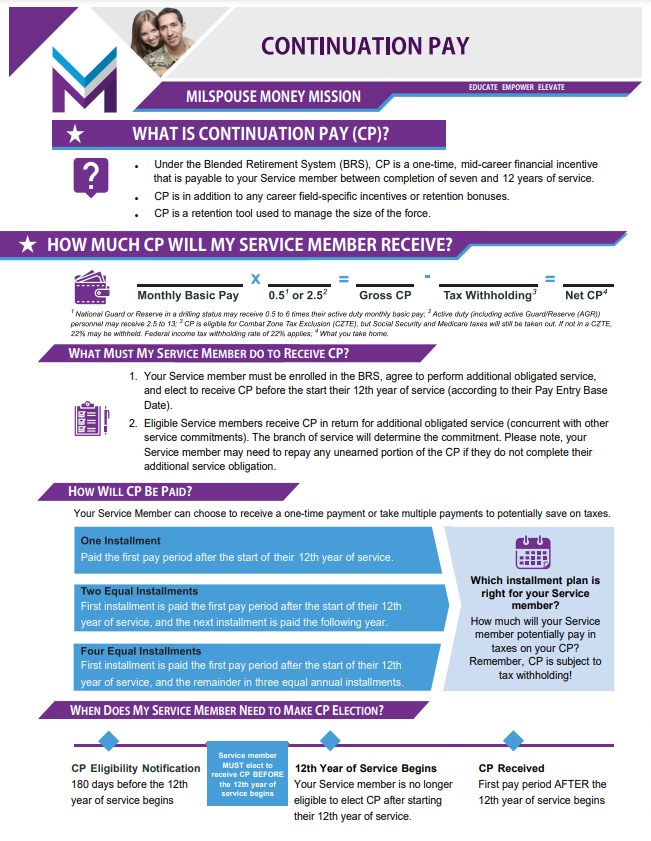Get Started
Congratulations! You have reached an important milestone in your military journey — the point where your spouse is approaching eligibility for continuation pay.
Continuation Pay Is Part of the Military's Blended Retirement System (BRS)
Financial Planning
Use this webpage to help you reassess your career goals and make important personal financial decisions as they pertain to continuation pay.
Financial Planning Considerations
Resources
Learn about the resources available within the military community. There are sources of support and information available online and at each installation.
Know What's Available
1
Getting Started
Continuation Pay (CP) is part of the military’s Blended Retirement System (BRS). It is a one-time direct cash payout to service members who have completed at least seven but not more than 12 years of service.
The objective of continuation pay is to offer midcareer service members a financial incentive to remain in their service in exchange for committing to at least four more years. Time of service is calculated from the service member’s pay entry base date (PEBD).
How much is continuation pay? It depends. Each service establishes its own criteria for when a service member is eligible to receive continuation pay and the amount they will receive. Factors, such as a critical skill set, training experience, or needs of the service may result in a higher multiplier for continuation pay. The amount can range from 2.5 to 13 times basic monthly pay for active component Service members (including Active Guard Reserve (AGR) and Full Time Support (FTS). Reserve Component members could be eligible for .5 to 6 times monthly basic pay (as if serving on active duty). Please note, continuation pay is its own distinct category and does not impact other types of special pay.

The Goal
The BRS blends a traditional military retirement pension, with a 401(k)-style retirement account called the Thrift Savings Plan (TSP).
- The retirement pension is typically earned after completing at least 20 years of service.
- The TSP is a tax-advantaged retirement account for Service members. Under the BRS, Service members who contribute at least 5% of their basic pay into the TSP, will receive 5% in automatic and matching contributions after serving two years.

Continuation Pay
As a component of the BRS, continuation pay is another part of the benefits package offered to the Service member that may be similar to a retention bonus awarded to someone in the civilian sector.
2
Financial Planning Considerations
A cash payout can have a very positive impact on your family’s financial security. Here are some tips to help your family plan and make the most of this benefit.
There are many good ways to use your continuation pay, but how can you make the most of this opportunity? One great place to start is by assessing your current financial situation. Speak with your spouse about your financial goals and update your family spending plan. If you need help with goal setting or budgeting, visit the Getting Started and Money Ready: Create a Budget sections for guidance.
Once you have prioritized your financial goals and know where your money is going, you will have a better understanding of how to best use your continuation pay.
Do you have credit card debt, a student loan, car payment, or other loan? Consider using continuation pay to get rid of debt. We suggest using one of the following strategies: the snowball method or the avalanche method. In the snowball method, you rank your debts from smallest balance to largest balance. Concentrate your efforts on paying off the smallest balance debt first, while making minimum payments on the other debts. When the smallest balance debt is paid off, concentrate your efforts on the next lowest balance until your are debt free. Use our online calculator below to assess your financial situation using the snowball method.

The second strategy, known as the avalanche or debt roll-down method, works in a similar fashion. Rank your debts from the highest to lowest interest rate. Concentrate your efforts on paying off the highest interest rate first. When it's paid off, apply those resources to the next highest interest rate balance until you are debt free. Click here and scroll down to Managing Debt 101 to see our videos. In addition, this calculator can help you decide whether the avalanche strategy works best for your financial situation.

Unexpected events happen to all of us, but we can be prepared financially. Experts suggest you have three to six months of living expenses saved in a readily available account like a money market or savings account. Read more about emergency funds in this blog.
What percentage is your spouse currently putting in? Contribute at least 5% to take full advantage of the matching contribution. The IRS limits how much a participant and employer can contribute to retirement accounts, so be careful not to overfund the TSP early in the year, or you could miss out on matching contributions. The IRS limits participant contributions (called the elective deferral limit) to $20,500 for 2022 with a $6,500 catch-up provision if you are over the age of 50. The limit for total contributions, which includes employer matching contributions, is $58,000. Visit the TSP website for more information.
Continuation pay is considered earned income and is taxable at ordinary income tax rates. It can be received in one lump sum or as series of equal installment payments, not to exceed four annual payments occurring over four consecutive years. It may be smart to take it over a few years if you are concerned that the bonus could push you into a higher tax bracket. Each person’s situation is unique, so discuss this with a tax professional.
You can contribute proceeds from your continuation pay to your Traditional or Roth Individual Retirement Account (IRA), if eligible. You are limited to contributing $6,000 for 2022 with an additional $1,000 catch-up if you are over 50. Remember, a contribution can be made to a spouse’s IRA if you file a joint tax return. There are phase-out limits for IRA contributions. Check with your installation’s personal financial counselor for more information.
You may be eligible for a tax deduction if you donate your continuation pay. Be sure to factor in all of your goals as you consider this option.
Recognize and protect your family from misleading consumer practices and identity theft. Scammers and unscrupulous businesses prey upon consumers, including Service members with large sums of money to invest. Be careful. Protect your family’s personal information and do your homework before investing or doing business with any person or organization.
- For more information on identity theft, visit the Federal Trade Commission (FTC) at www.consumer.gov or call 1-877-ID-Theft.
- You can also visit Military Consumer (MC), managed by the FTC, at http://www.militaryconsumer.gov.
Important note: What happens if your spouse receives continuation pay and does not serve the required years of service? All or a portion of continuation pay may need to be repaid depending on why the commitment was not fulfilled.
For a quick reference guide for continuation pay, download this handout.

Reserve and National Guard Service members are eligible for continuation pay. The bonus amount can be from 0.5 to six times monthly basic pay, and the multiplier used is at the discretion of their service.
In summary, plan for the best way to use continuation pay. Every family’s situation is unique with different needs and goals. This one-time cash payment can help you meet your financial goals now and in the future.
3
Resources
Accredited and trusted by the military community, here are some excellent resources to get you started:
✓Money Ready: Create a Budget & Manage Debt
✓Continuation Pay Rates: Click Here
✓Blended Retirement System: Click Here
✓BRS Continuation Pay Fact Sheet: Click Here
Recent Blogs
Giving Military Kids the Tools to Be Financially Capable
Military families are known for resilience, yet the frequent moves, deployments, and changes in income that come with military life can make financial stability feel like a juggling act. But these unique challenges may offer a golden teaching opportunity for military kids. By talking about finances openly and equipping kids with financial skills early on,…
Read MoreMarch Money Moves: Navigating Tax Season While Preparing for Summer Fun
As we welcome the arrival of spring and the promise of warmer weather, it’s easy to get caught up in thoughts of summer plans and family vacations. But with tax season in full swing, it’s important to balance excitement for the upcoming months with a push to wrap up tax season. While those topics couldn’t…
Read MoreCommunicating with Your Partner About Finances: A February Focus on Financial Wellness
Talking Money with Your Partner As we celebrate loving relationships this month, it’s important to remember that not all conversations come up roses between couples. Sometimes discussing finances can be tricky and stir up negative emotions. Open communication about money is vital for building trust and nurturing a healthy relationship. Whether you’re a new couple…
Read MoreBuild Financial Wellness from the Ground Up in 2025
There’s something magical about the ball dropping at midnight and turning the page to a new year. For an instant, it feels like you’ve got a clean slate, and anything is possible. In some ways that’s true, but as the calendar page turns, your responsibilities, bills and financial challenges remain. Many people make resolutions to…
Read More5 Financial Resolutions to Start the New Year Off Right
You don’t need to wait until January to take a fresh look at your finances. Get a jump on the new year with these five resolutions — they can really pay off over the next 12 months. 1. Set/update your budget Setting a budget is the first step in a military family’s financial planning. And…
Read More5 Financial Power Moves for MilSpouses
During National Veterans and Military Families Month in November, we salute the strength of our families as they support the mission of our community. MilSpouses, especially, display determination as they face the challenges of military life. We see you navigate frequent moves, deployments and often raising children as a solo parent. We understand your motivation…
Read MoreThe Year In Review: Bring Your Financial Picture into Focus
It can be fun and even eye-opening to watch those year-end montages reminiscing about the year. If you ever have that moment when you say to yourself, “Wait, that was this year?”, you could also imagine how easy it could be to lose track of the goals and financial plans you set in motion when…
Read MoreNow’s the Time to Think About Life Insurance
Hey, MilSpouses, it’s Life Insurance Awareness Month! Okay, so maybe that doesn’t make you want to break out the cake and ice cream, but life insurance is an important part of your financial plan. It can help take care of your family, giving them financial security if something happens to you or your service member.…
Read More









